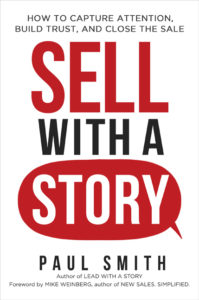Podcast: Play in new window | Download | Embed
Subscribe: RSS
Podcast (sell-with-a-story-series1): Play in new window | Download | Embed
Subscribe: RSS
{The 6th in a series of the 25 most useful sales stories.}
 One of the things I learned from interviewing professional buyers was that there are two things salespeople can do to immediately earn buyers’ trust and credibility. In the words one buyer used to explain it, “First, tell me when you can not help me. And second, tell me when you made a mistake before I find out from someone else.”
One of the things I learned from interviewing professional buyers was that there are two things salespeople can do to immediately earn buyers’ trust and credibility. In the words one buyer used to explain it, “First, tell me when you can not help me. And second, tell me when you made a mistake before I find out from someone else.”
Here’s the logic behind the first one: If you’re honest enough to tell buyers when your company is not well suited for a particular need they have, they’re more likely to believe you when you tell them you are the best solution.
The only problem with that situation is that it may not occur until after you and the buyer have been doing business together for a while. That’s where storytelling comes in handy. Even if you haven’t yet come across a problem they have that you can’t solve, you can still give them a sense of confidence that you would tell them if that situation does arise.
Now, you obviously can’t accomplish that by just telling them, “Of course, I’ll always tell you when I’m not the best option for you.” That’s not believable. But you can do that through a story about a time you have done that with another customer. Here’s what the whole situation might look like in practice:
Today, Jamie Lancaster is a vice president at Kroger. But back in 2001, he worked at Fifth Third Bank. They were wrestling with an IT problem and called in two suppliers to ask for potential solutions. Jamie told me,
The first guy answered every question I asked with, ‘Yeah, we can do that!’ He thought his confidence was reassuring me. In fact, it was having the opposite effect. These weren’t the most common problems. If he thinks he already has all the answers, maybe he doesn’t really understand the questions.
The second guy that came in was very different. He asked good questions, acknowledged how tough the problems were. And he said things like, ‘I’ve not seen that before. Let me see how we could fix it.’ I could tell he was actually trying to solve the problem in his head instead of focusing on closing the sale.
The other benefit of this humbler approach is that it acknowledged to Jamie that Fifth Third was on the cutting edge in some way. If the bank’s problems stumped the expert salesman, they must be out front. Paying your buyer an honestly deserved compliment like this usually doesn’t hurt.
Not surprisingly, Jamie gave the business to the second guy.
So, if you’ve ever done anything like the second salesperson in Jamie’s story, craft a story about it and have it ready to share with your next prospect.
And if you haven’t done anything like this before, you should start. Otherwise, you’re the first guy.
Use these links to subscribe to this podcast on iTunes or Stitcher, or Podbean.
Source: Sell with a Story: How to Capture Attention, Build Trust, and Close the Sale, by Paul Smith.
—
 Paul Smith is one of the world’s leading experts on business storytelling. He’s a keynote speaker, storytelling coach, and bestselling author of the books Lead with a Story, Parenting with a Story, and Sell with a Story.
Paul Smith is one of the world’s leading experts on business storytelling. He’s a keynote speaker, storytelling coach, and bestselling author of the books Lead with a Story, Parenting with a Story, and Sell with a Story.


 Connect with him via email here.
Connect with him via email here.
Follow him on Facebook, LinkedIn, Twitter, and Instagram.
Sign up for his newsletter here to get one new story a week delivered to your inbox.

